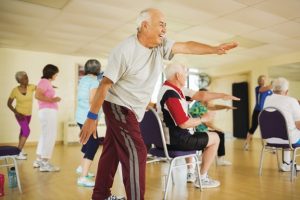Make Your Exercise Class a Better Experience
Walking out of the middle of an exercise class is more common than you might think. Do you walk out from sheer frustration, pain or both? My review is based on my own experience and those of my friends.
 At 60+ years of age, I accept I have osteoarthritis and osteoporosis, chronic conditions that can limit my activity. I treat each condition differently. As a trainer, I know how to focus my energies and where to go to take the best classes. I strengthen my bones, exercise major muscle groups that move my joints, stretch often and eat well. All along avoiding pain at all costs! Going to a gym with quality instructors makes all the difference. Effective classes are taught by instructors who follow industry guidelines, studied kinesiology or are trained by nationally accredited agencies as personal trainers or physical therapists.
At 60+ years of age, I accept I have osteoarthritis and osteoporosis, chronic conditions that can limit my activity. I treat each condition differently. As a trainer, I know how to focus my energies and where to go to take the best classes. I strengthen my bones, exercise major muscle groups that move my joints, stretch often and eat well. All along avoiding pain at all costs! Going to a gym with quality instructors makes all the difference. Effective classes are taught by instructors who follow industry guidelines, studied kinesiology or are trained by nationally accredited agencies as personal trainers or physical therapists.
I asked a few friends if they ever left a class in the middle of a program (not including spinning). Their reactions were mixed. Some told me they had a difficult time keeping up and felt embarrassed, the music was not to their liking because of style or volume, the instructor’s exercise cues were not clearly timed (a cue to change patterns is supposed to be seconds before you are expected to move), and others had nagging pain that threw their timing off.
Take responsibility for a good workout
If you are a novice, returning to exercise after an extended absence, suffer with a chronic condition that limits you or you’re fed up with soreness after class – there are solutions. It starts with observing a class to see if how interesting it is to you. Perhaps, have a conversation with the instructor beforehand and talk about your situation. Be brief, there is not enough time for a lengthy conversation before class. If not, be sure to catch the instructor next time. Keep in mind, if you have a medical condition that has not been diagnosed by your doctor, do not expect a diagnosis from the instructor because it is beyond their scope of practice. However, they may be able to make suggestions how to adapt and modify your exercises.
A few times a week I take aerobics – spin or step. One of my favorite instructors was teaching step, so I went to her class, knowing my hip pain might flair up. I positioned myself in the front with only one riser (versa the two I usually use), until my hip began to hurt. I was frustrated because I wasn’t keeping up with the rhythm of the class. I didn’t want to distract the others so instead, I went in the back of the room and stretched, then returned. Leaving the floor had nothing to do with the instructor, it was my way of coping.
Be Upfront
The instructor should demonstrate warm-up routines that mimic moves your body will be doing during class. Warm-ups also help flush blood and oxygen to your muscles. This will prepare your body when you get into the meat of the class. Position yourself in the room where you can see and hear the instructor well. If you stand in the back, others in front of you can be a distraction.
Is the instructor yelling at the top of their lungs and playing music so loud you need earplugs, or worse you can’t hear at all? Is the music even appropriate? It’s all worthy of consideration so you can have a fun, pain-free experience.
What’s next?
Learn to feel your movements (proprioception) from the inside out. When you do, your brain will transfer the information through the nervous system, thus making it easier to move your body properly and self-correct. It takes practice.
Find a quiet moment, lie down on a flat surface with your eyes closed. Relax as you scan your body from head to toe, paying close attention to which parts feel tight, uneven, etc. It takes practice and maybe another set of eyes to guide you because our everyday positions become habit and we won’t necessarily feel the difference between corrective form and not. Watch your refection in a mirror or when you walk alongside a store window. Do you walk straight, or do you slump with your shoulders rounded and protruding forward? Think of it as a scientific experiment.
Cool It
Your cool-down is just as important as your warm-up. It prepares your body for homeostasis, when your body returns to normal temperature. If the instructor does little to cool you down, be sure to do so on your own. You want to feel invigorated rather than wiped out when you’re finished.
Practice working your plan
If your fitness plan includes remaining active, getting stronger, reducing inflammation and stiffness, it can be tricky to say the least if you don’t know how. By learning practical ways, you can stay in class longer and enjoy the experience.
Group class not right for you? Consider having a Lori Michiel Fitness certified personal trainer come to your home. Whether it’s for a jumpstart on your exercise routine, or a regular weekly or monthly visit, we’ll develop a custom “class” just right for you!
